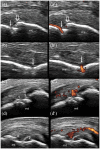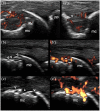The sonographic identification of cortical bone interruptions in rheumatoid arthritis: a morphological approach
- PMID: 33948124
- PMCID: PMC8053750
- DOI: 10.1177/1759720X211004326
The sonographic identification of cortical bone interruptions in rheumatoid arthritis: a morphological approach
Abstract
Bone erosions are the hallmark of structural damage in rheumatoid arthritis (RA). Among imaging techniques, ultrasonography (US) has emerged as an accurate, reliable, repeatable, low-cost and non-invasive imaging modality to detect erosive changes in RA. However, small interruptions of the cortical bone detectable by last generation US equipment do not necessarily represent bone erosions. According to the available data, in addition to cortical bone interruption itself, only a few morphological US findings have been proposed to define RA bone erosions. However, other additional features may be considered to facilitate the interpretation of US cortical bone interruptions in RA. These could be summarised using the following four domains: size, site, shape and scenery. This hypothesis article provides a critical literature review of US features characteristic of RA bone erosions and pictorial evidence supporting the potential role of a morphological analysis in the US identification of bone erosions in RA patients.
Plain language summary: The ultrasonographic morphology of cortical interruptions is helpful for the identification of bone erosions in rheumatoid arthritis: the "four Ss" approach Bone erosions are characteristic features of rheumatoid arthritis. They are associated with a more aggressive disease and with irreversible physical disability. In recent years, ultrasonography has emerged as an accurate and reliable technique for the detection of bone erosions, that appear as interruptions of the cortical bone with variable size. However, cortical bone interruptions do not necessarily represent bone erosions. Since bone erosions represent the earliest evidence of the destructive behaviour of RA, their identification is crucial.Besides the cortical interruption itself, only a few morphological ultrasonographic features were proposed to characterise bone erosions in rheumatoid arthritis.We believe that a morphological approach, including size, site, shape and scenery, may be considered to facilitate the interpretation of ultrasonographic cortical bone interruptions in rheumatoid arthritis.In this hypothesis article we carried out a critical review of the scientific literature and provided extensive pictorial evidence of the ultrasonographic spectrum of cortical interruptions supporting the potential role of considering the "four Ss" for the ultrasonographic identification of bone erosions in rheumatoid arthritis.
Keywords: OMERACT; bone erosions; rheumatoid arthritis; structural damage; ultrasonography.
© The Author(s), 2021.
Conflict of interest statement
Conflict of interest statement: E.F. has received speaking fees from AbbVie, Bristol-Myers Squibb, Celgene, Janssen-Cilag, Novartis, Pfizer, Roche and Union Chimique Belge Pharma. M.D.C. has received speaking fees from AbbVie, Novartis, Pfizer and Sanofi Aventis. W.G. has received speaking fees from AbbVie, Celgene, Grünenthal, Pfizer and Union Chimique Belge Pharma. All other authors have declared no conflict of interest.
Figures






References
-
- McInnes IB, Schett G. The pathogenesis of rheumatoid arthritis. N Engl J Med 2011; 365: 2205–2219. - PubMed
-
- Cipolletta E, Hurnakova J, Di Matteo A, et al.. Prevalence and distribution of cartilage and bone damage at metacarpal head in healthy subjects. Clin Exp Rheumatol, Epub ahead of print 2 March 2021. - PubMed
-
- Hurnakova J, Filippucci E, Cipolletta E, et al.. Prevalence and distribution of cartilage damage at the metacarpal head level in rheumatoid arthritis and osteoarthritis: an ultrasound study. Rheumatology (Oxford) 2019; 58: 1206–1213. - PubMed
-
- Aletaha D, Funovits J, Smolen JS. Physical disability in rheumatoid arthritis is associated with cartilage damage rather than bone destruction [published correction appears in Ann Rheum Dis 2011; 70: 1880]. Ann Rheum Dis 2011; 70: 733–739. - PubMed
Publication types
LinkOut - more resources
Full Text Sources
Other Literature Sources

